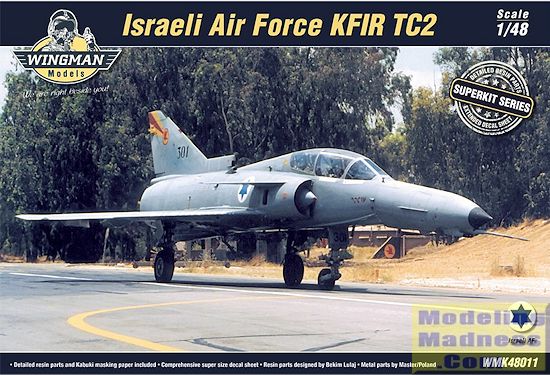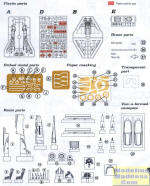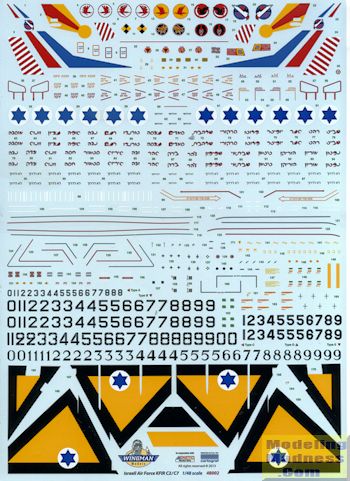
Wingman Models 1/48 Kfir TC2
| KIT #: | 48011 |
| PRICE: | 75.Euros |
| DECALS: | None |
| REVIEWER: | Scott Van Aken |
| NOTES: | Multimedia kit with resin and photo etch. |

| HISTORY |
The Kfir programme originated in the quest to develop a more capable version of the IAI Nesher, which was already in series production. After General De Gaulle embargoed the sale of arms to Israel, the IAF feared that it might not have an upper hand over its adversaries in the future, which were receiving increasingly advanced Soviet aircraft. The bulk of the Israeli Air Force had been locked into the Mirage but was quickly facing problems because Mirage numbers were somewhat depleted after the Six-Day War. Domestic production would avoid the problem of the embargo completely; efforts to reverse engineer and reproduce components of the Mirage were aided by Israeli espionage efforts to obtain technical assistance and blueprints from third party Mirage operators.
Two powerplants were initially selected for trials, the General Electric J79 turbojet and the Rolls-Royce Spey turbofan. In the end, the J79 was selected, not least because it was the same engine used on the McDonnell Douglas F-4 Phantom II, which the Israelis began to acquire from the United States in 1969, along with a license to produce the J79 themselves. The J79 was clearly superior to the original French Atar 09, providing a dry thrust of 49 kN (11,000 lbf) and an afterburning thrust of 83.4 kN (18,750 lbf).
In order to accommodate the new powerplant on the Mirage III's airframe, and to deliver the added cooling required by the J79, the aircraft's rear fuselage was slightly shortened and widened, its air intakes were enlarged, and a large air inlet was installed at the base of the vertical stabilizer, so as to supply the extra cooling needed for the afterburner. The engine itself was encased in a titanium heatshield.
A two-seat Mirage IIIBJ fitted with the GE J79 made its first flight in September 1970, and was soon followed by a re-engined Nesher, which flew in September 1971.
An improved prototype of the aircraft, with the name Ra'am B ("Thunder") the Ra'am A was the Nesher, made its first flight in June 1973. It had an extensively revised cockpit, a strengthened landing gear, and a considerable amount of Israeli-built avionics. The internal fuel tanks were slightly rearranged, their total capacity being increased to 713 US gal (2,700 l).
The Kfir TC.2 was a two-seat training variant developed from the C.2. It has a longer and lowered nose to improve the pilot's view. The C.2 was an aerodynamically improved version of the C.1 and the TC.2 included all those improvement. Ten aircraft were produced.
| THE KIT |
 This kit is, like others from Wingman Models, basically a Kinetic kit with
all sorts of additional bits and pieces added to it. This pretty much means that
you have no reason for any aftermarket and you will find all you need in the
box.
This kit is, like others from Wingman Models, basically a Kinetic kit with
all sorts of additional bits and pieces added to it. This pretty much means that
you have no reason for any aftermarket and you will find all you need in the
box.
Since Kinetic does not do a two seat Kfir, you will find the standard Kfir kit as the basis for this conversion. The molding on the kit is standard Kinetic and if you have built one, you know what to expect. To do this conversion, you need to remove the kit nose from the intakes forward as well as cut off the upper fuselage spine. Wingman includes superbly done resin replacement bits with the nose comprising three major parts. The cockpit tub and area where the intakes attach is one piece while on the underside of this fits the nose gear well and the forward section is the new longer nose. To cap it off is a metal nose tip from Masters. This company also provides a metal pitot and AOA probe. Instructions are quite specific on assembling all this as well as the proper way to remove the kit spine.
Of course, the resin does not stop there. You are provided with a pair of bang seats that have the belts already molded in place. Canopy breakers and the pull handles are in photo etch. Control sticks, instrument panels and their respective anti-glare panels are in resin. The blast shield for the rear canopy (which is apparently retracted behind the front seat when not in use) is an acetate piece.
Other resin bits include the wheels, the aft canopy frame, three-piece
supersonic fuel tanks and the afterburner can as well as a couple of smaller
bits. The three fins for each of the fuel tanks are provided a s photo etch
parts. This kit has a pair of very nicely molded vacuform canopies and there are
photo etch mirrors that fit inside. The kit windscreen is used. A set of paper
canopy and windscreen masks is included, these having masks for the resin wheels
as well.
s photo etch
parts. This kit has a pair of very nicely molded vacuform canopies and there are
photo etch mirrors that fit inside. The kit windscreen is used. A set of paper
canopy and windscreen masks is included, these having masks for the resin wheels
as well.
The instructions are superbly done and in color to help you with construction. Those areas that need to be cut away or drilled are clearly marked. Throughout there is provided color information for the cockpit, seats, wheel wells and gear/gear doors.
Wingman Models has included their usual superlative decal sheet, printed by Cartograf. The sheet is huge and has pretty much all the markings you need to do any of the ten TC.2s built. Wingman uses their generic IAF Kfir sheet from kit 48002 so there are markings on there that are not used on the two seater such as the big orange triangles. Not shown is a very small additional sheet that has a few TC.2 specific markings.
The color guide provides specific markings for eight aircraft, all in the FS 36320/36375, two grey shades that are very close to each other in tone. Also included is a complete stencil placement guide, this being on a very large sheet so placement will not be an issue.
| CONCLUSIONS |
If you have never built one of Wingman's Superkits, then you are in for a real treat. They are packed full of all the bits you need to make an exceptional model. The resin is superbly done, the photoetch is not overwhelming and is appropriate and they provide markings for all the aircraft built. Though the initial price seems a bit high, when you add up all that is included, it is a good deal.
| REFERENCES |
http://en.wikipedia.org/wiki/IAI_Kfir
January 2015
Thanks to www.wingmanmodels.com Available from Squadron, Hannants, Lucky Model and Shop of Phantoms.
If you would like your product reviewed fairly and fairly quickly, please contact the editor or see other details in the Note to Contributors.